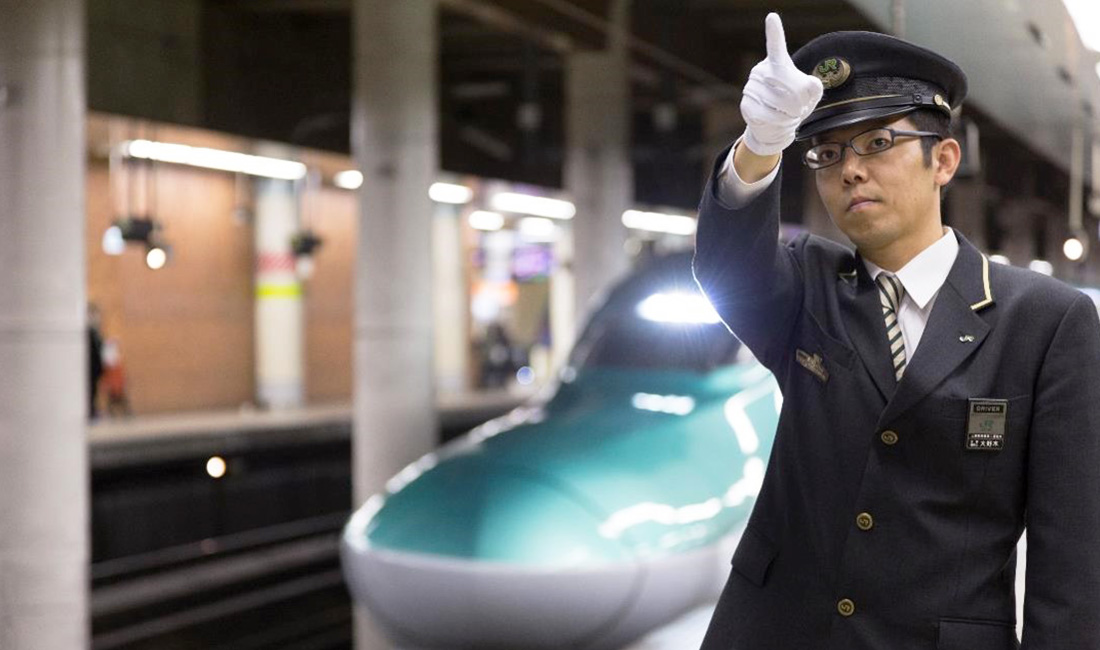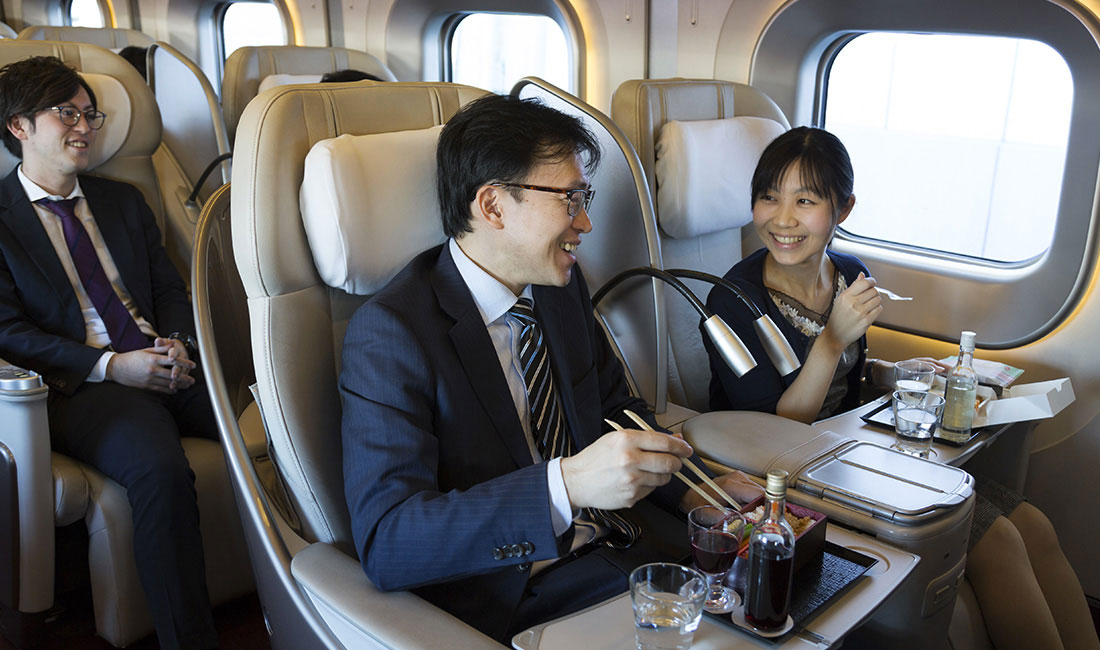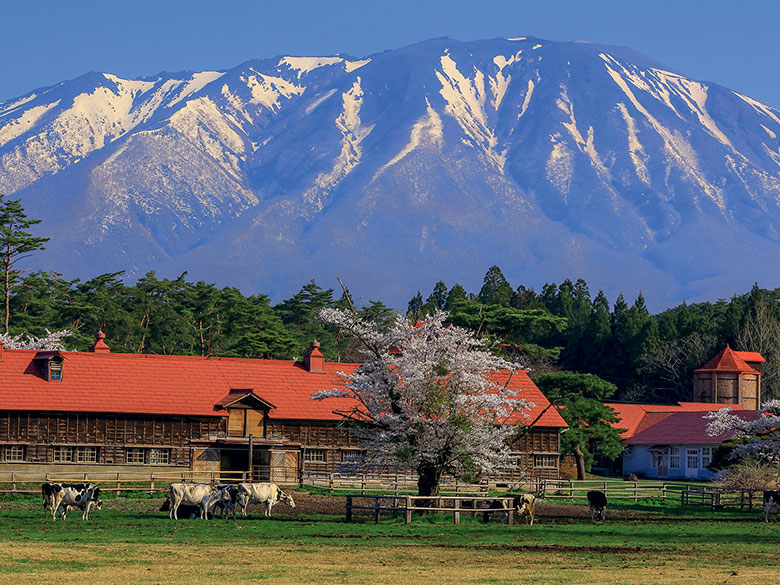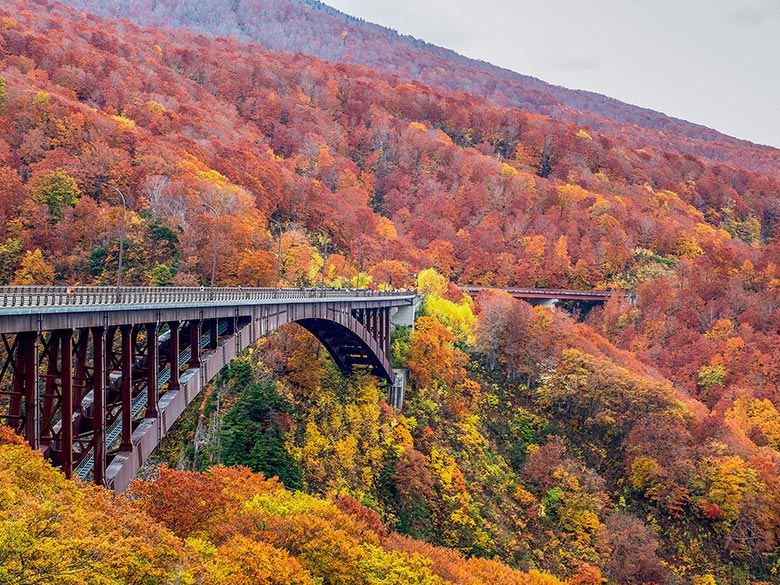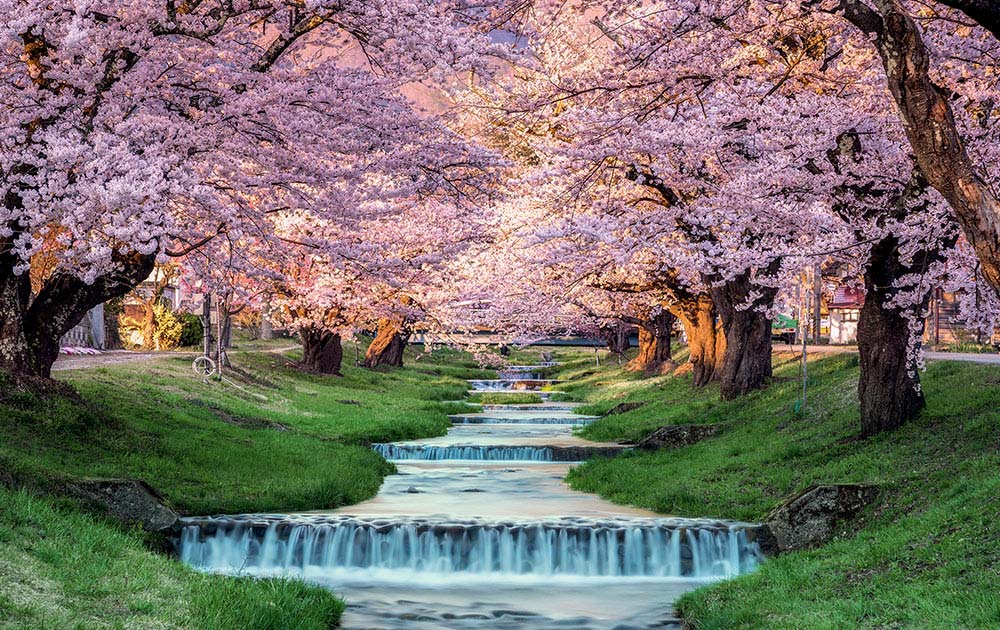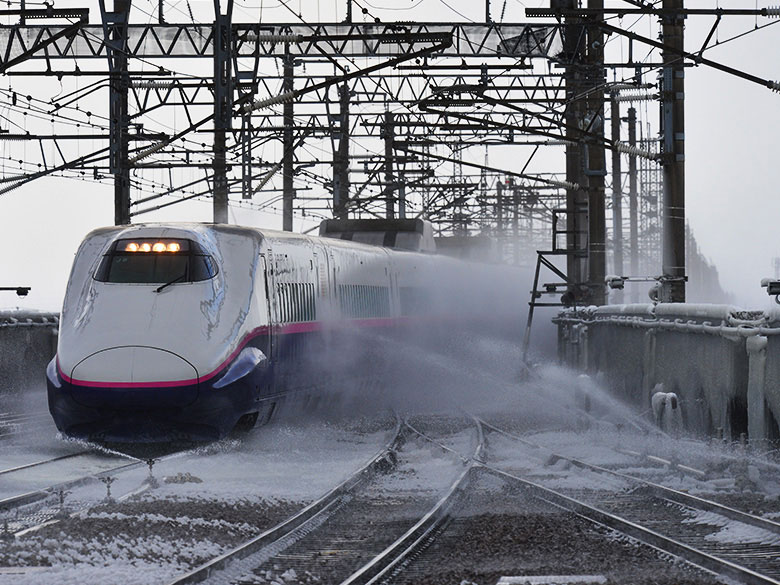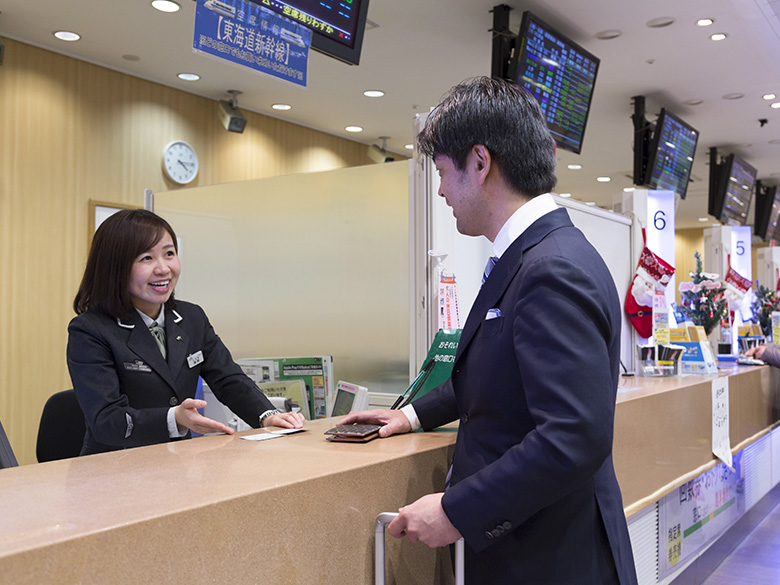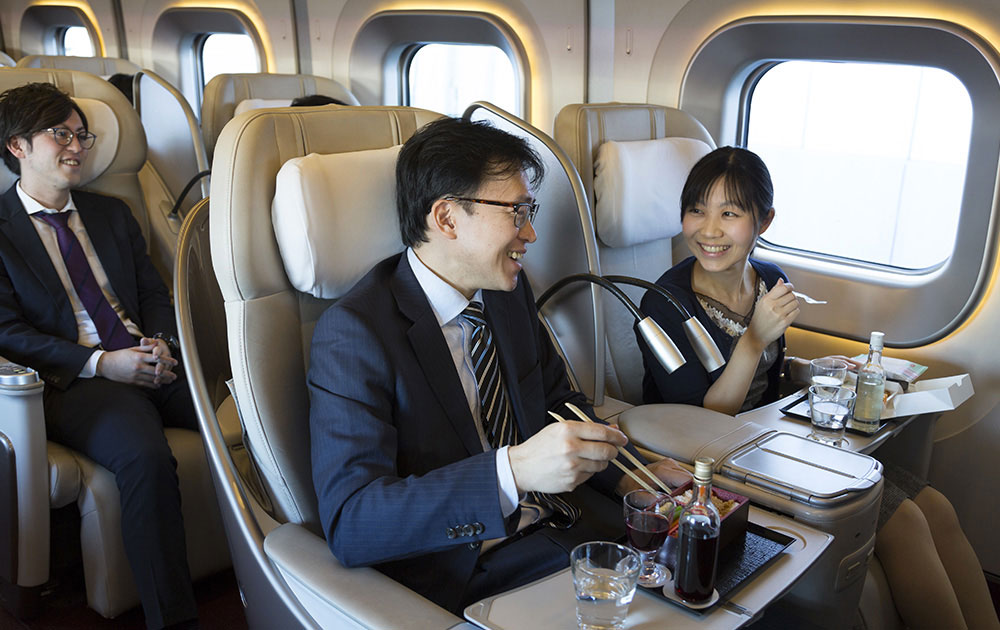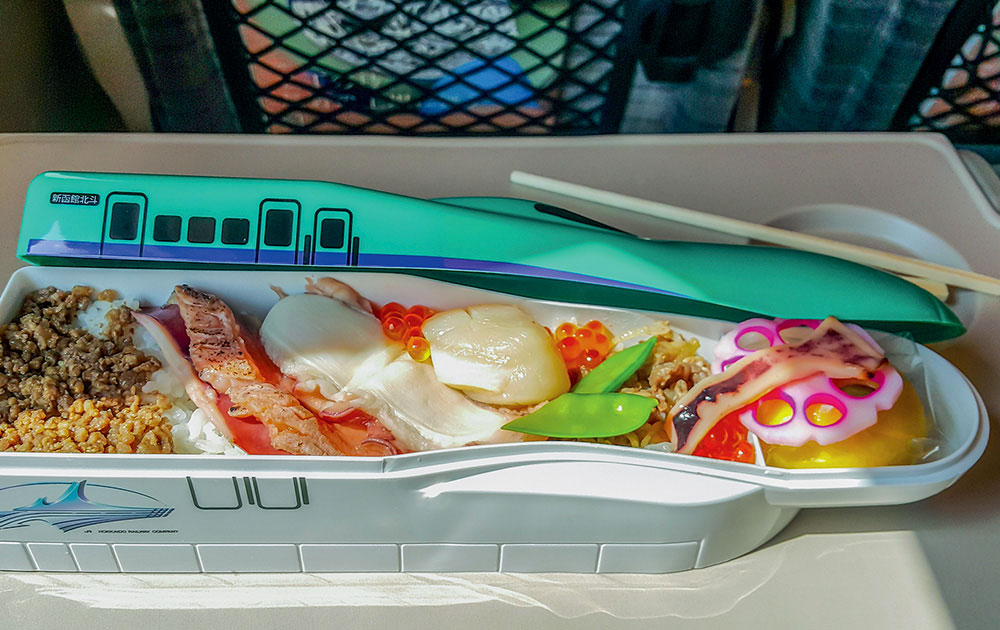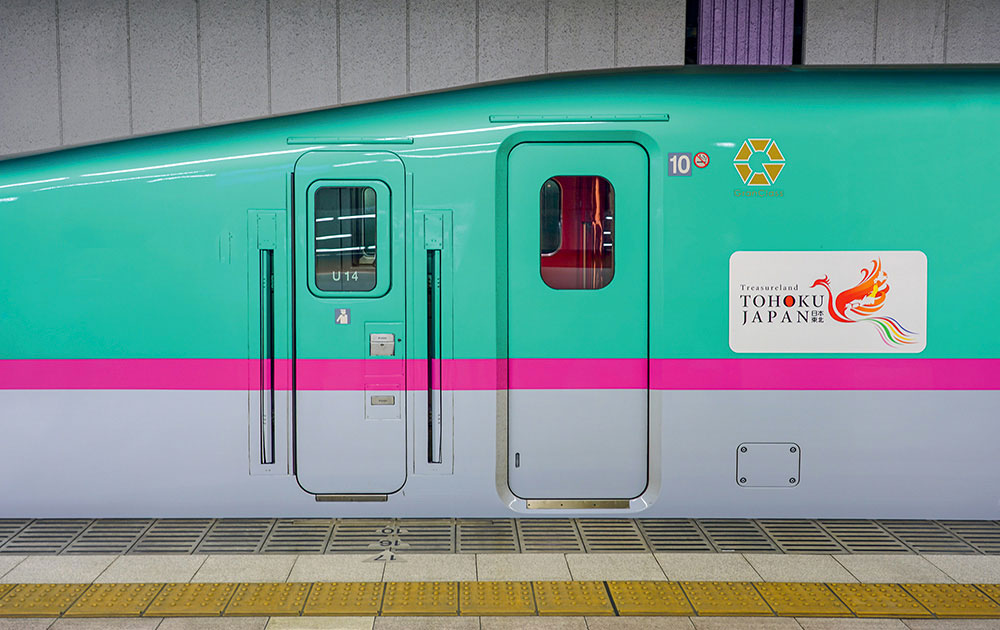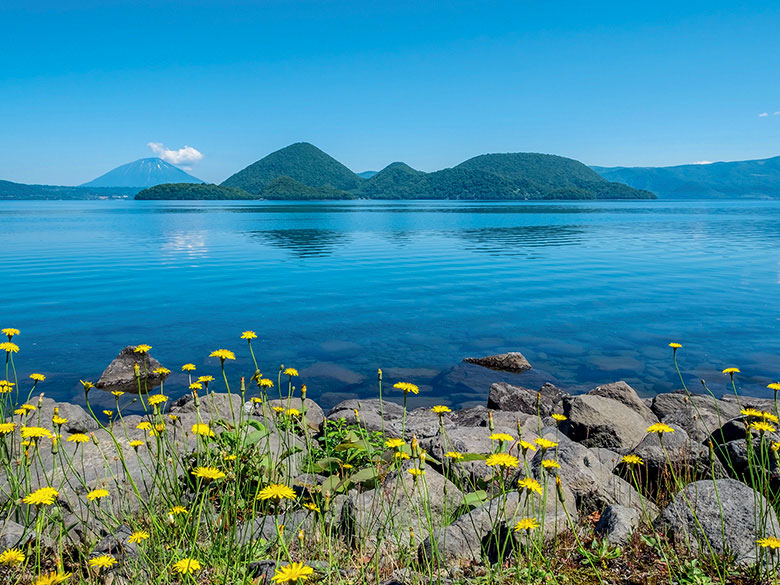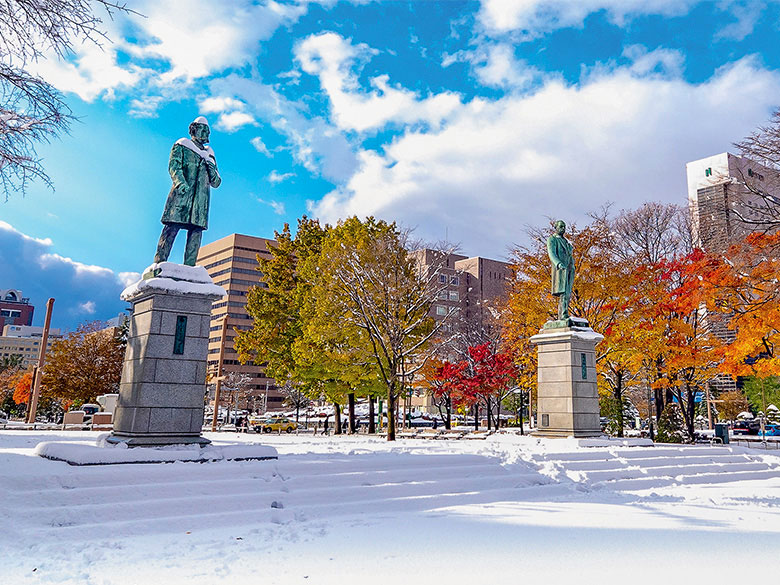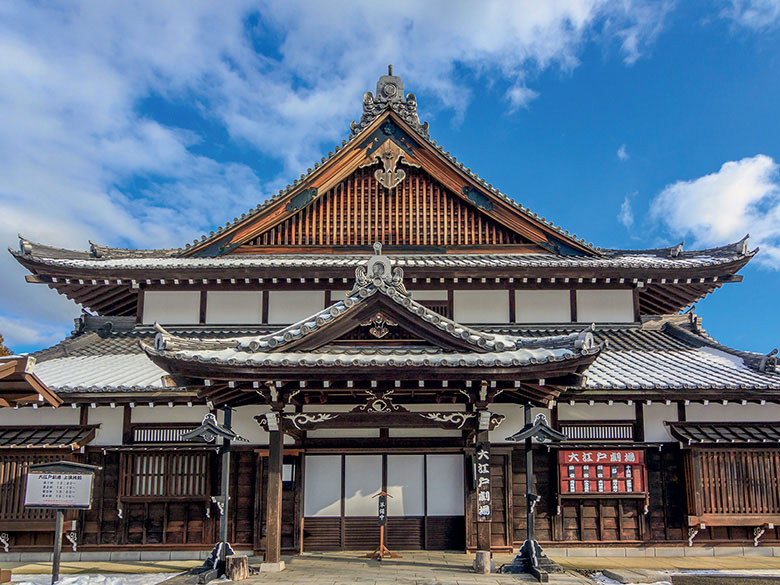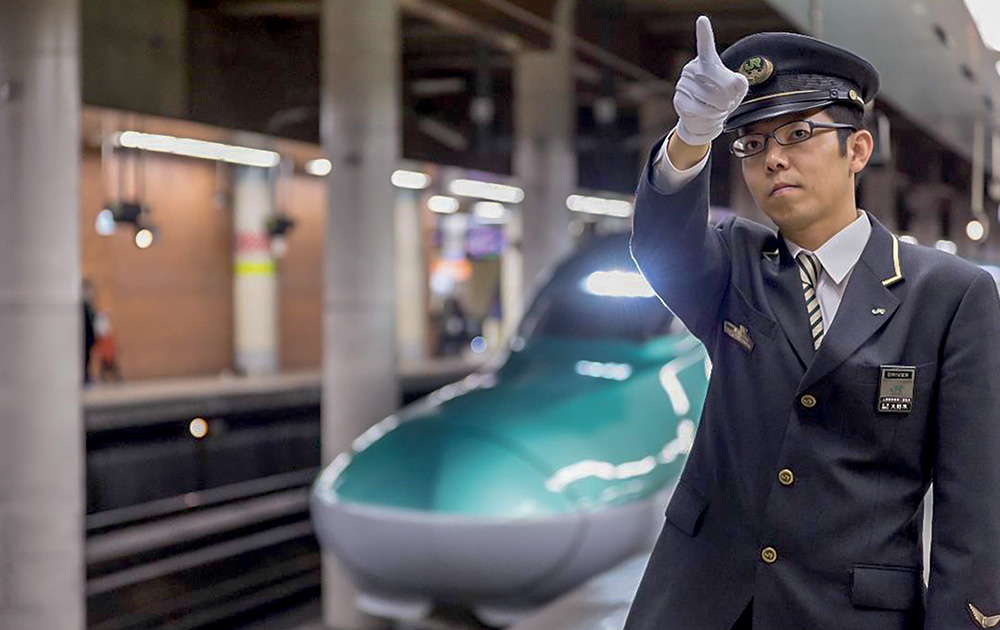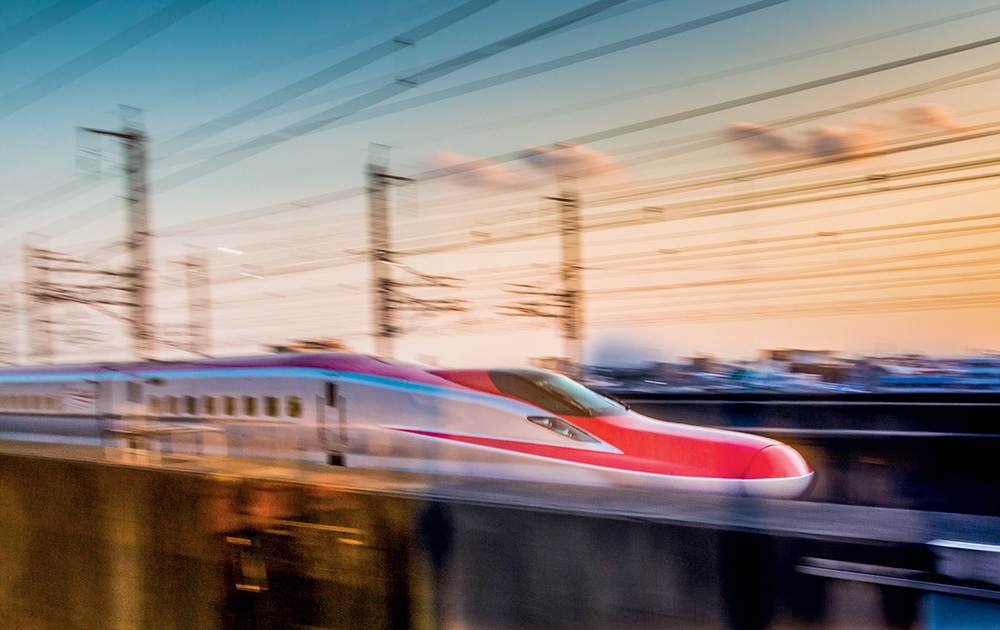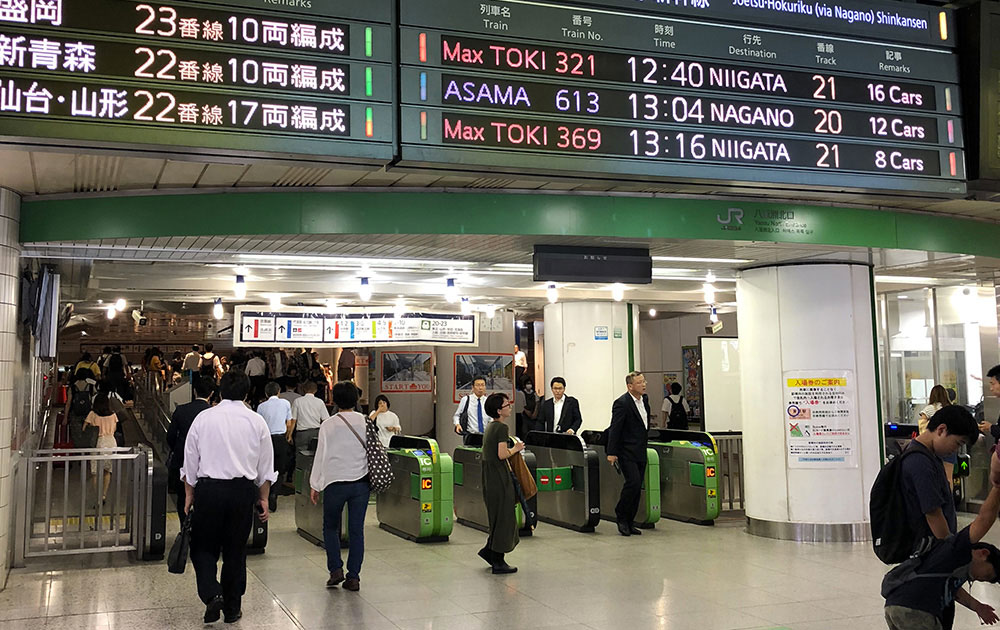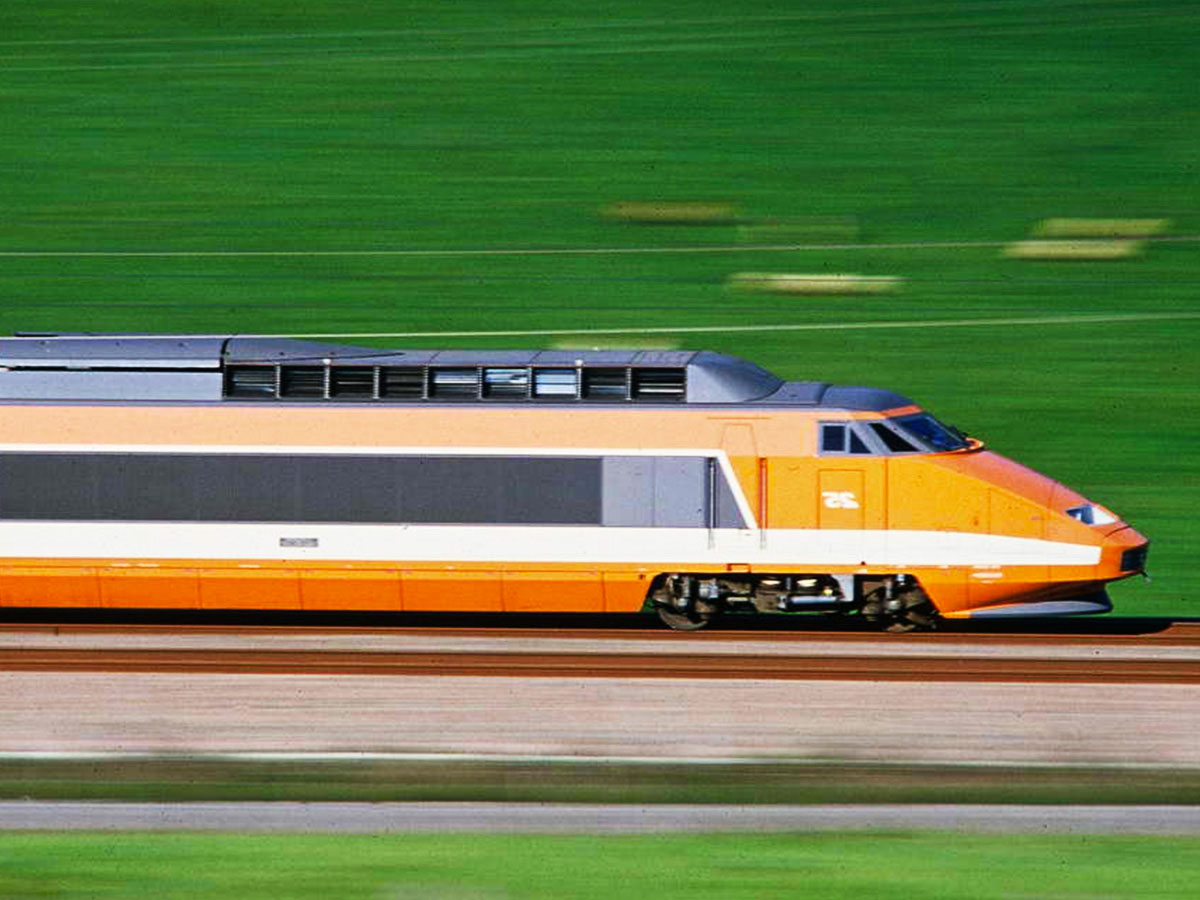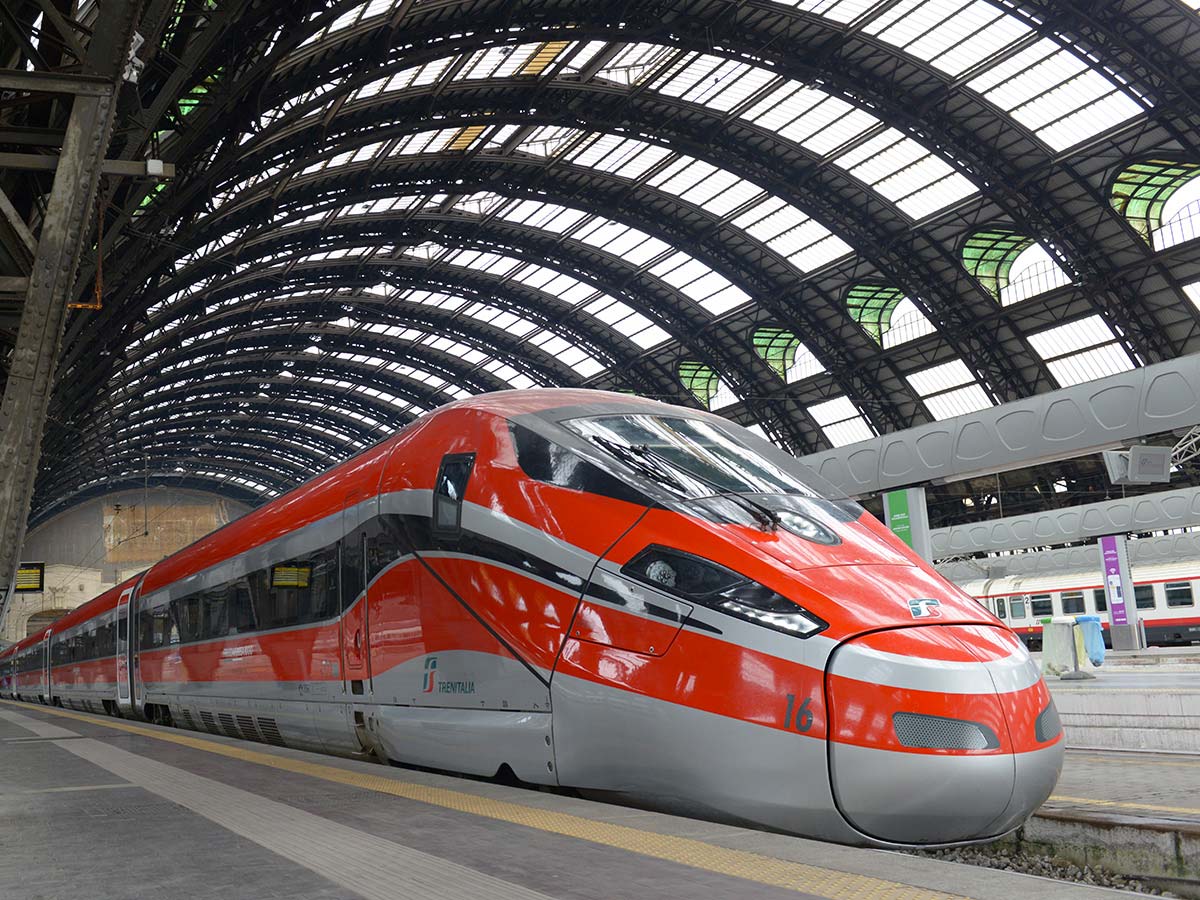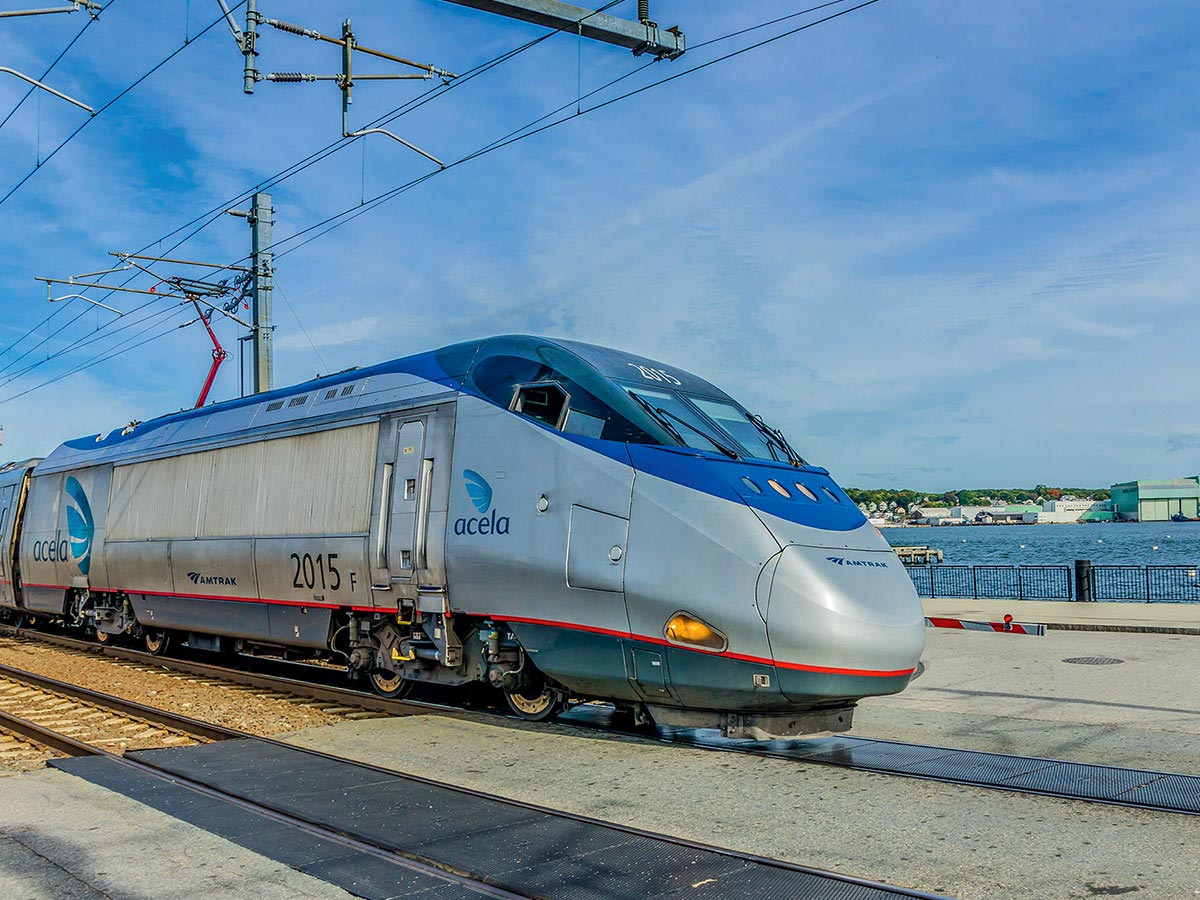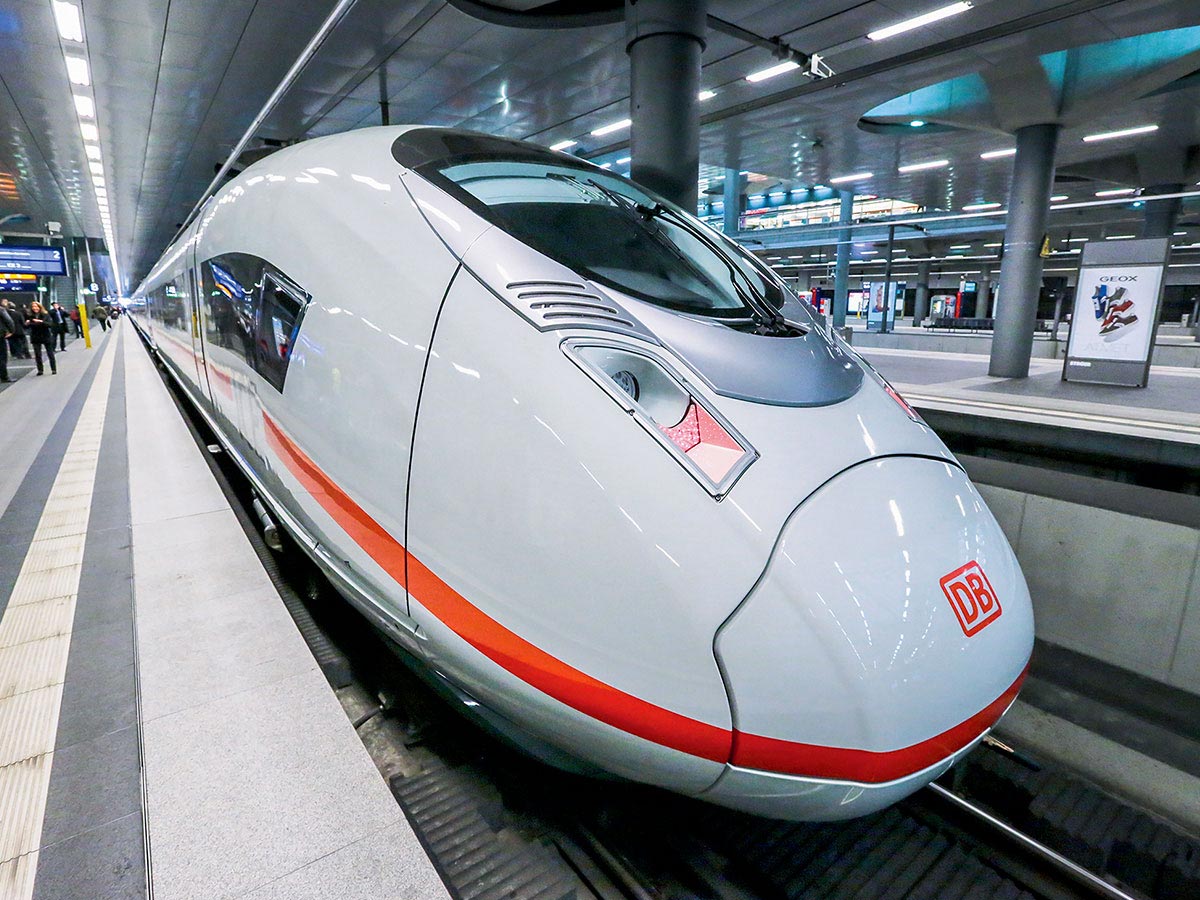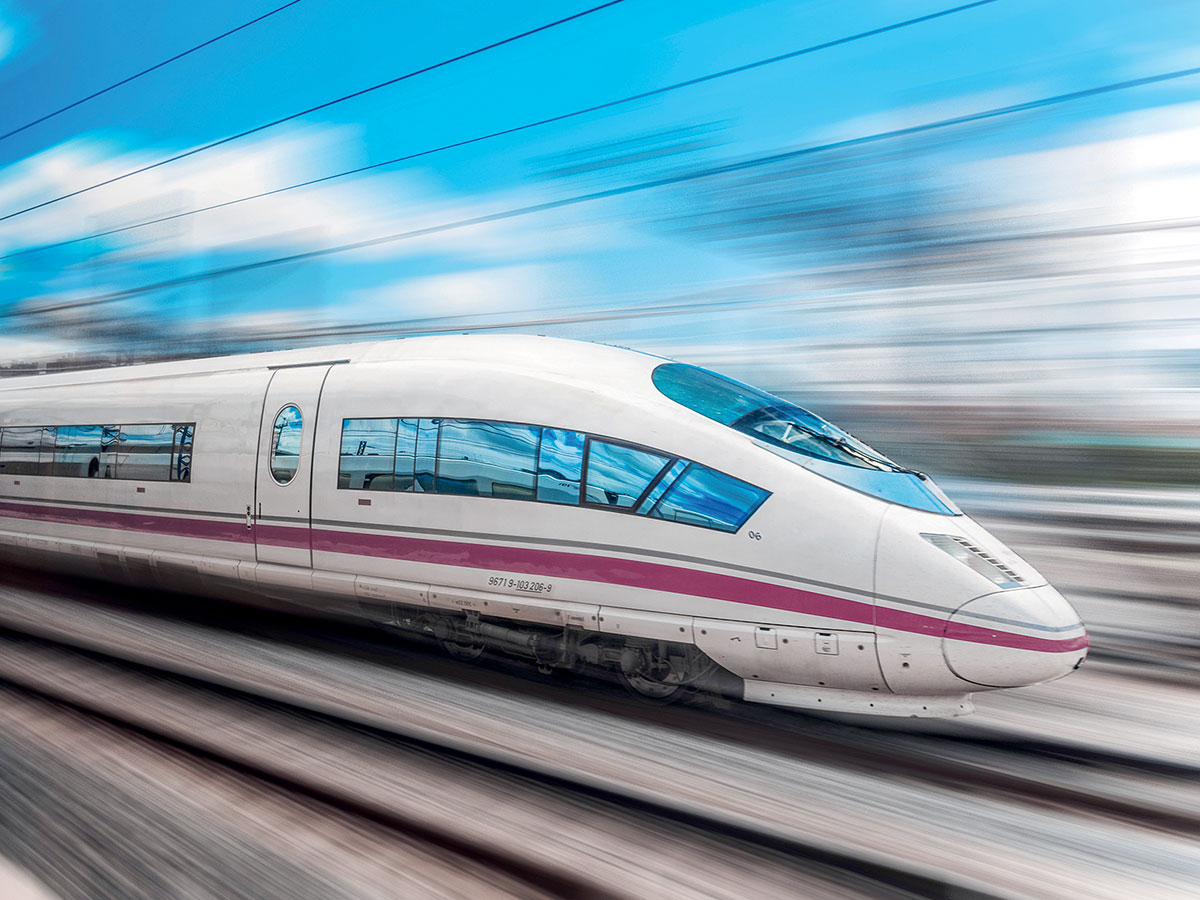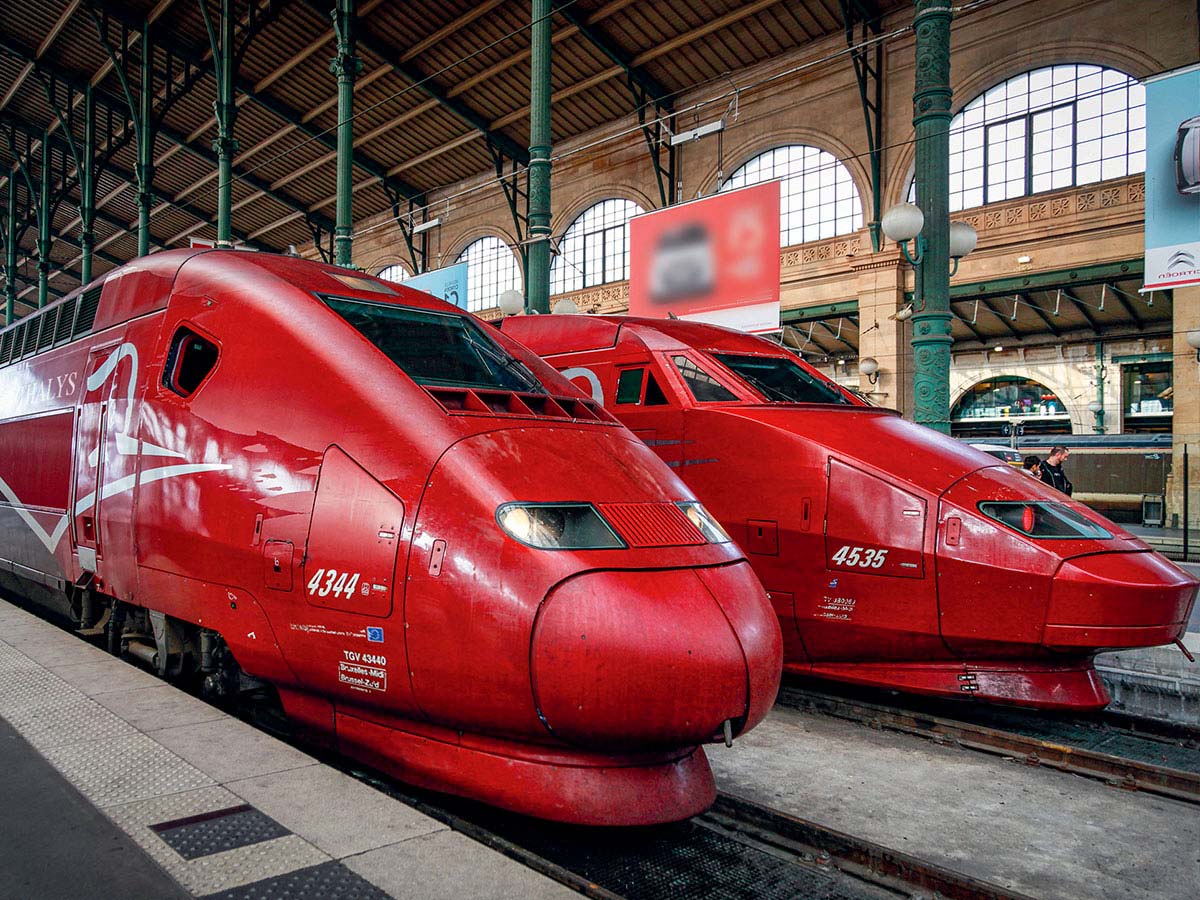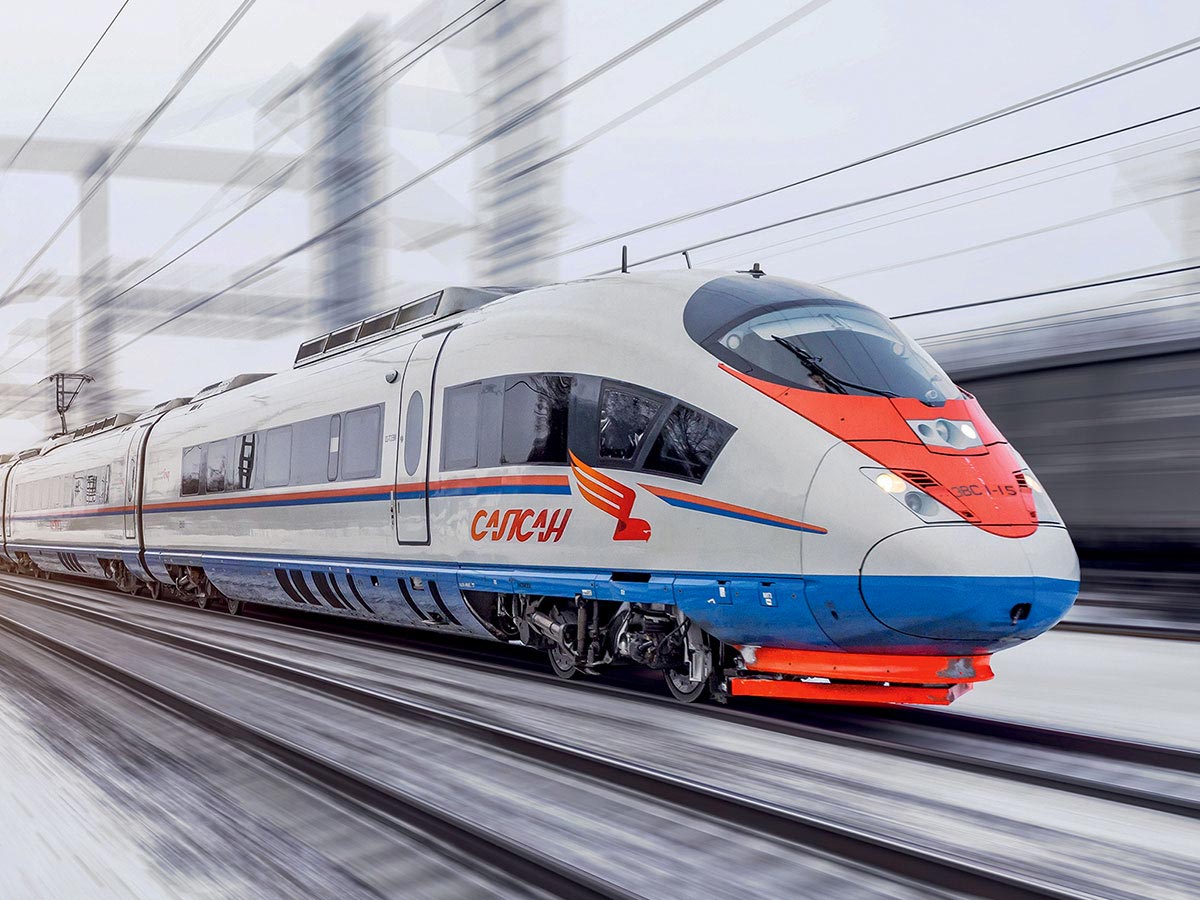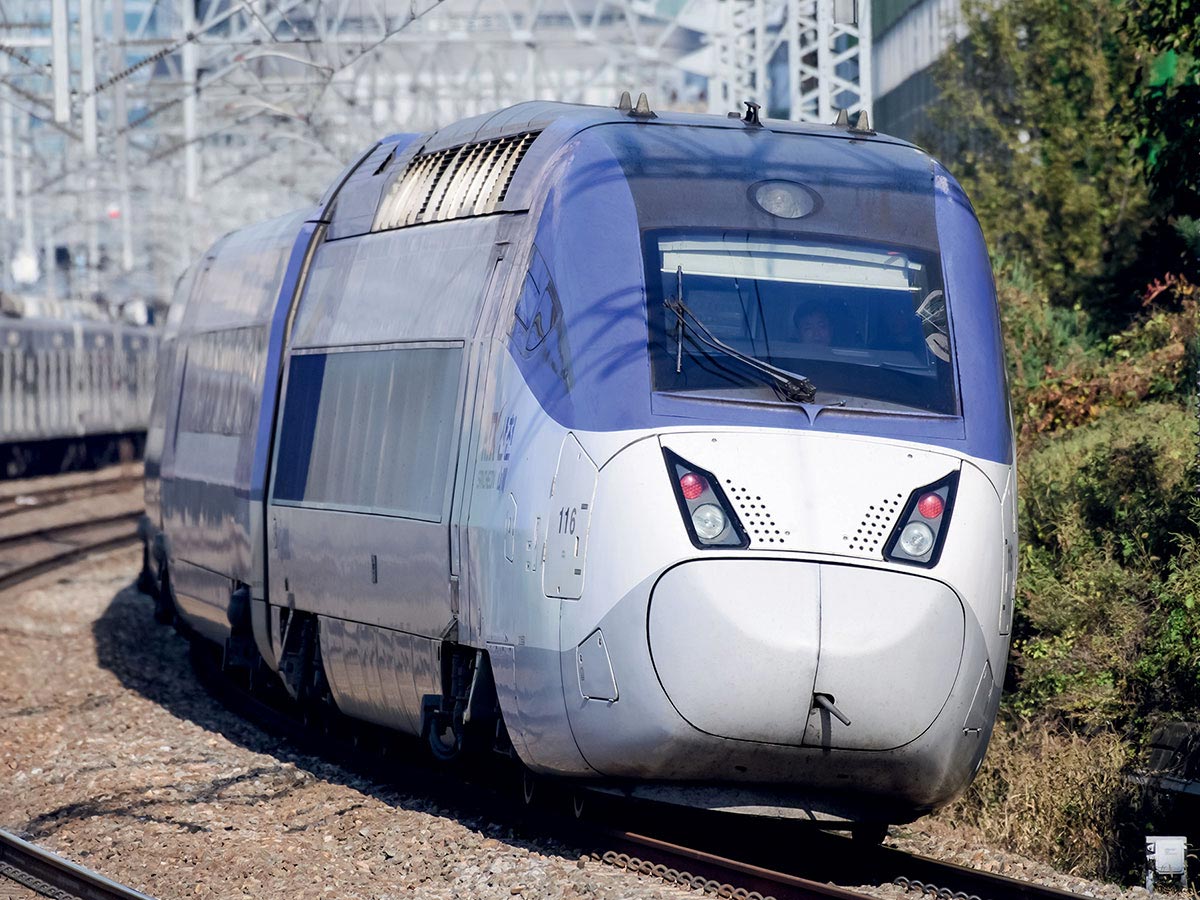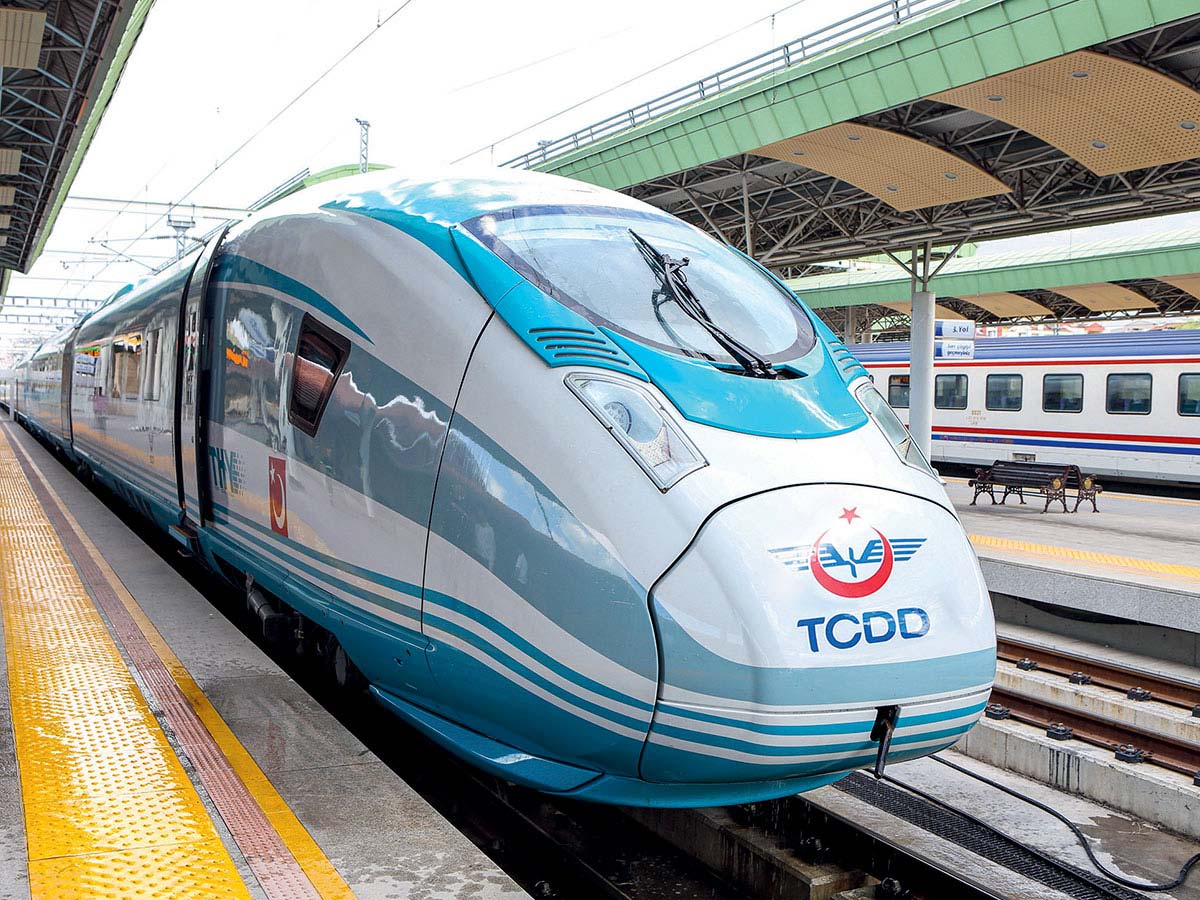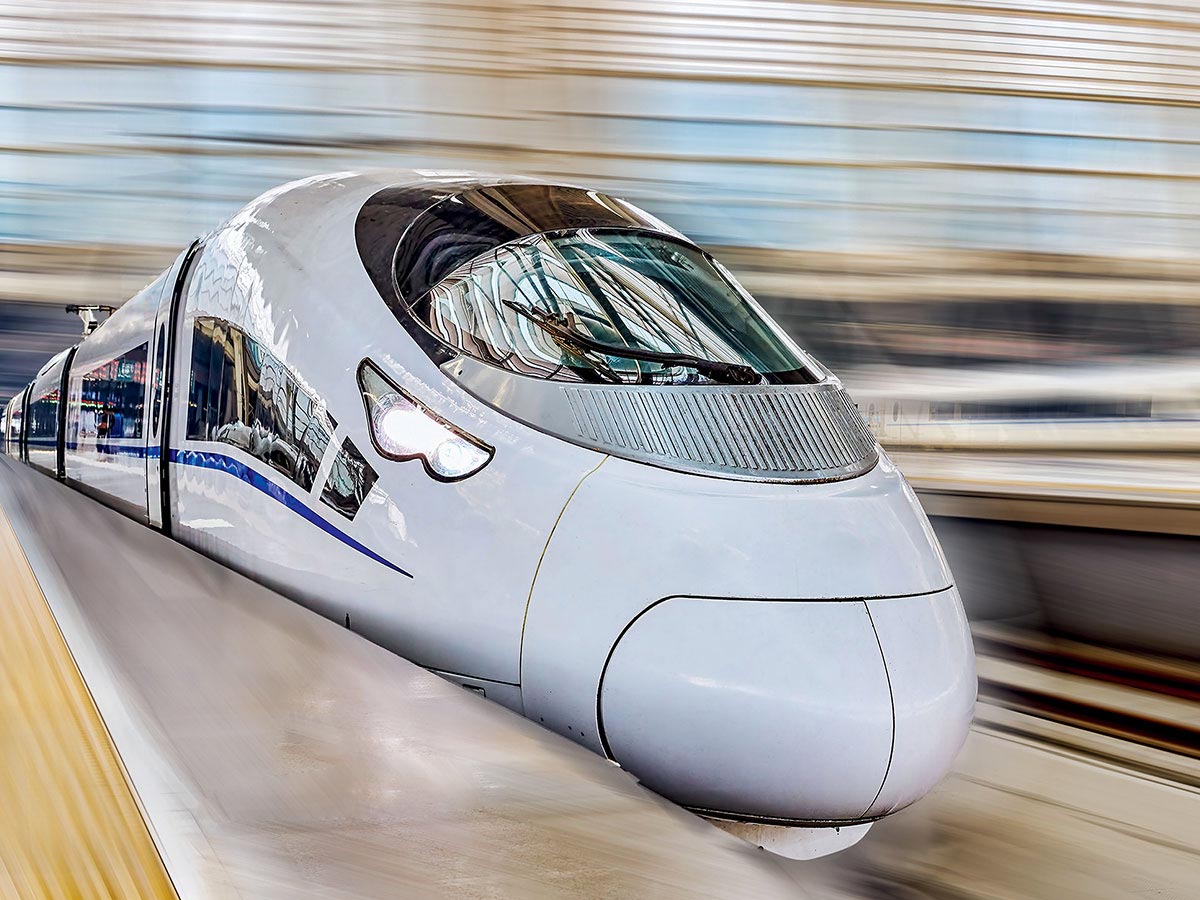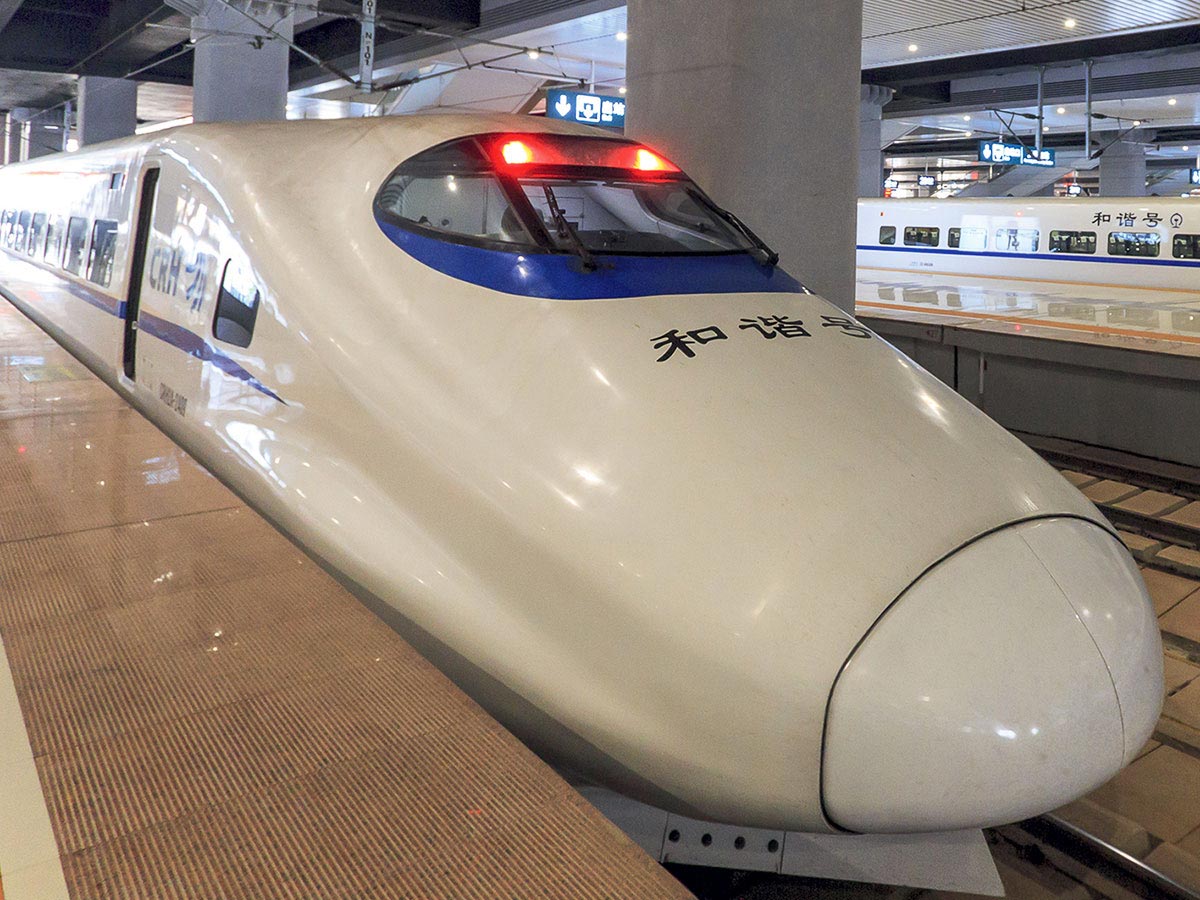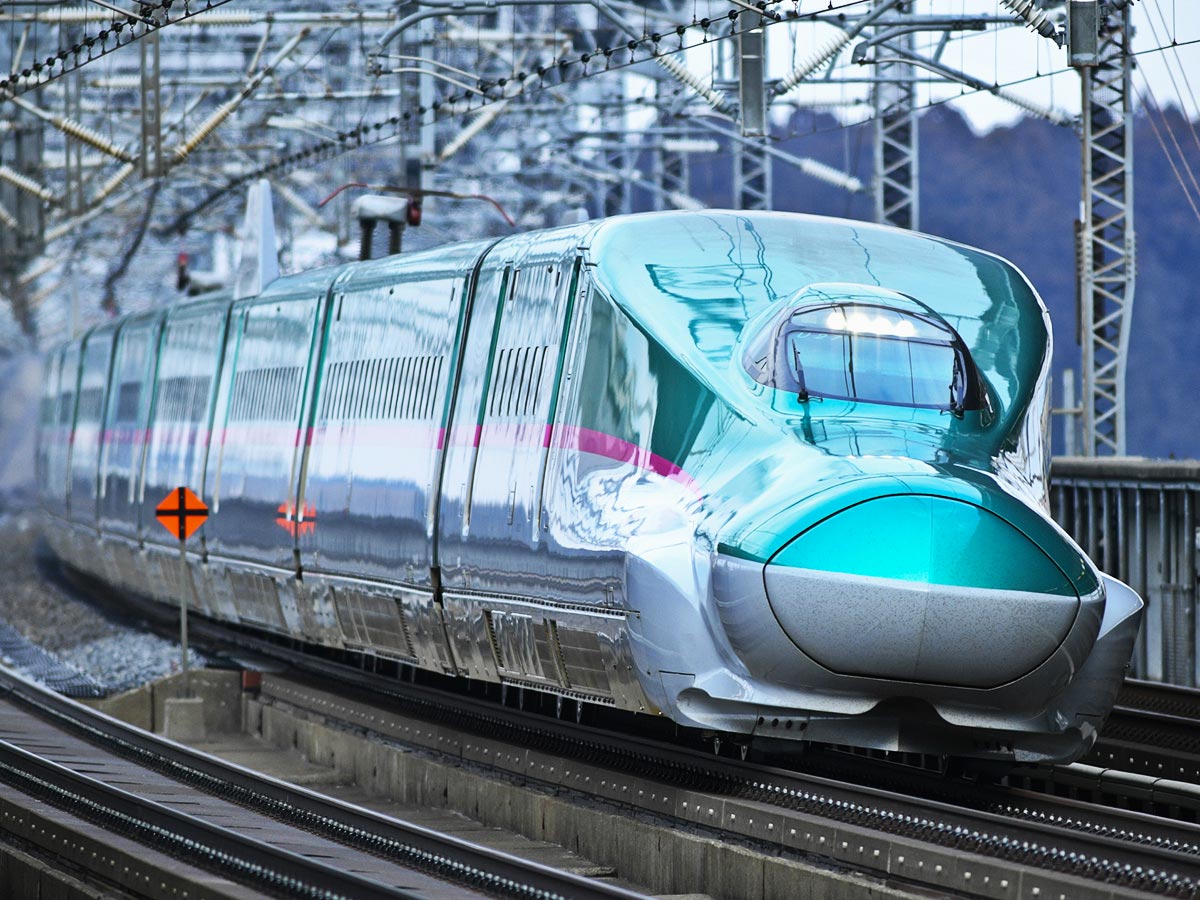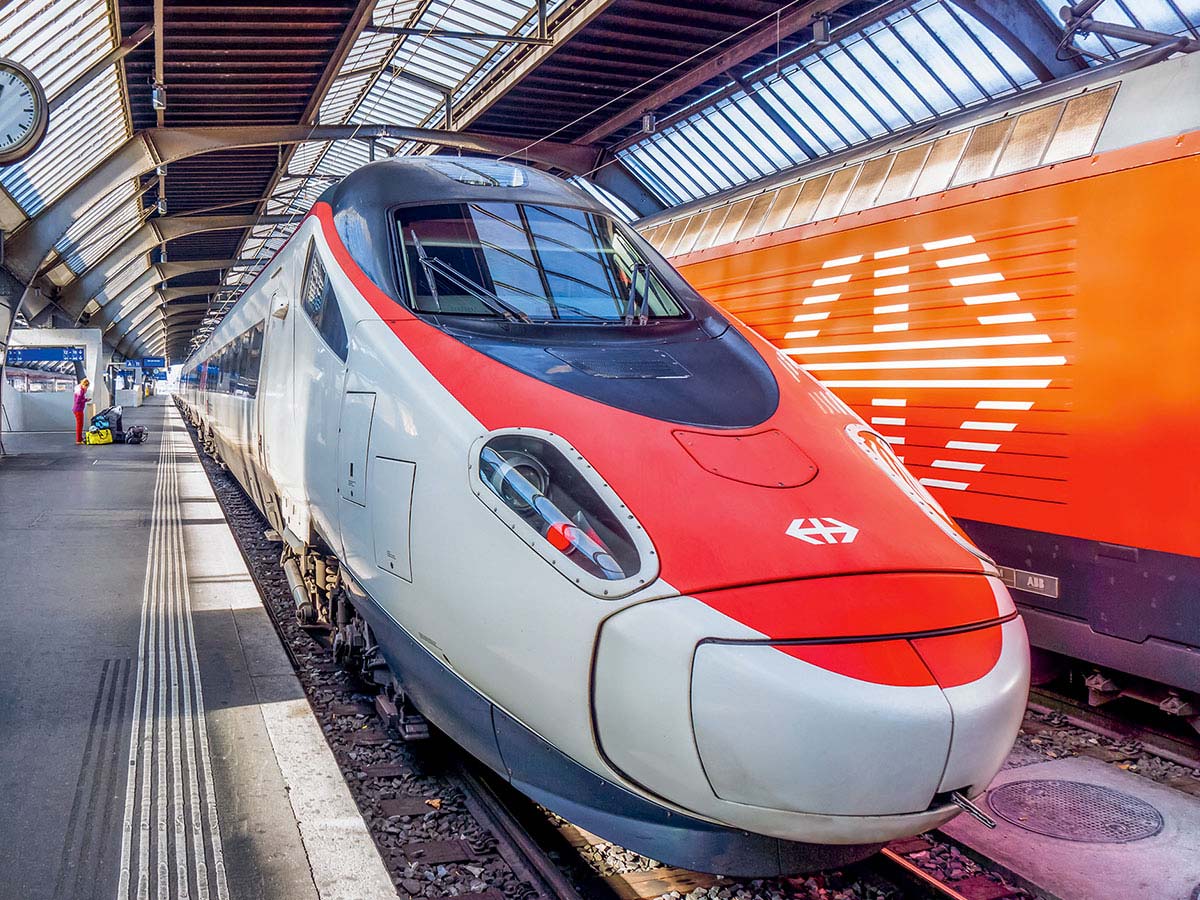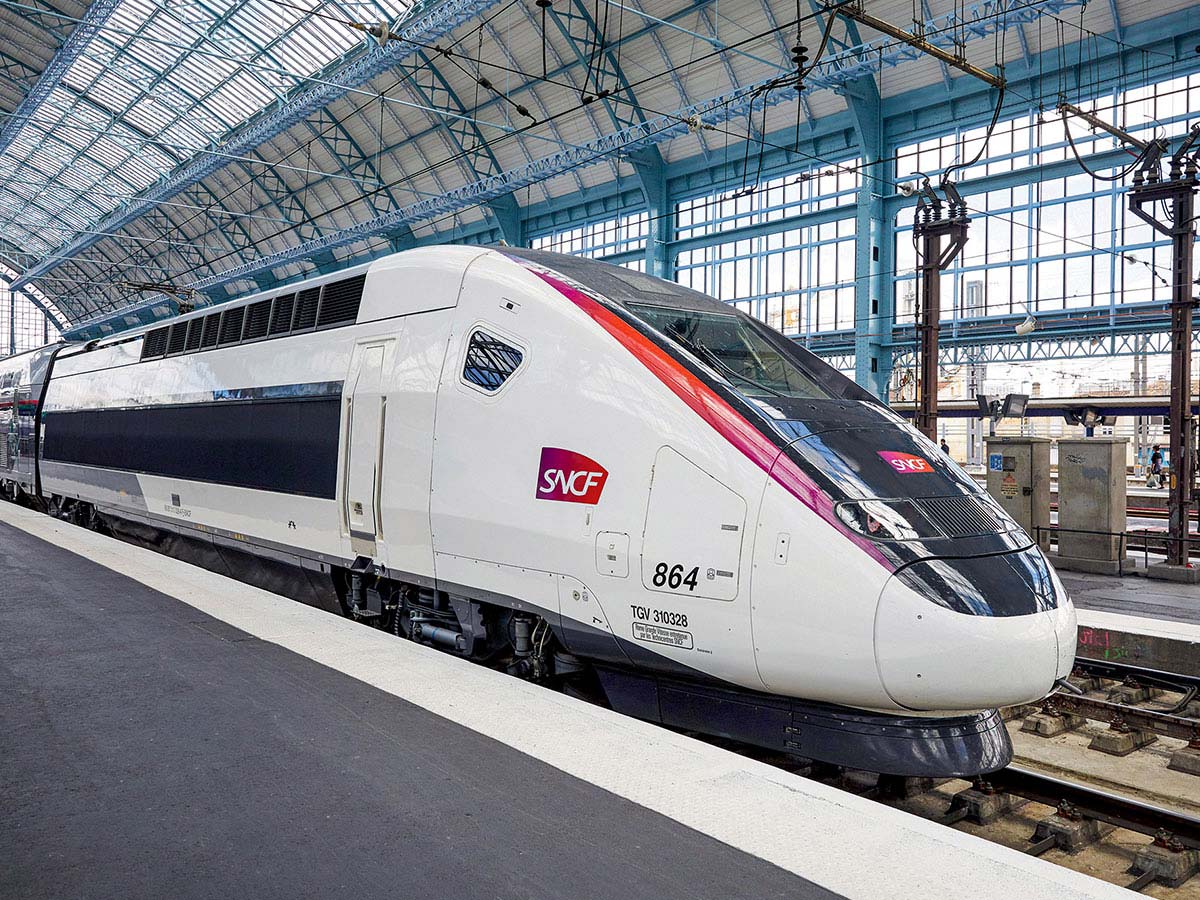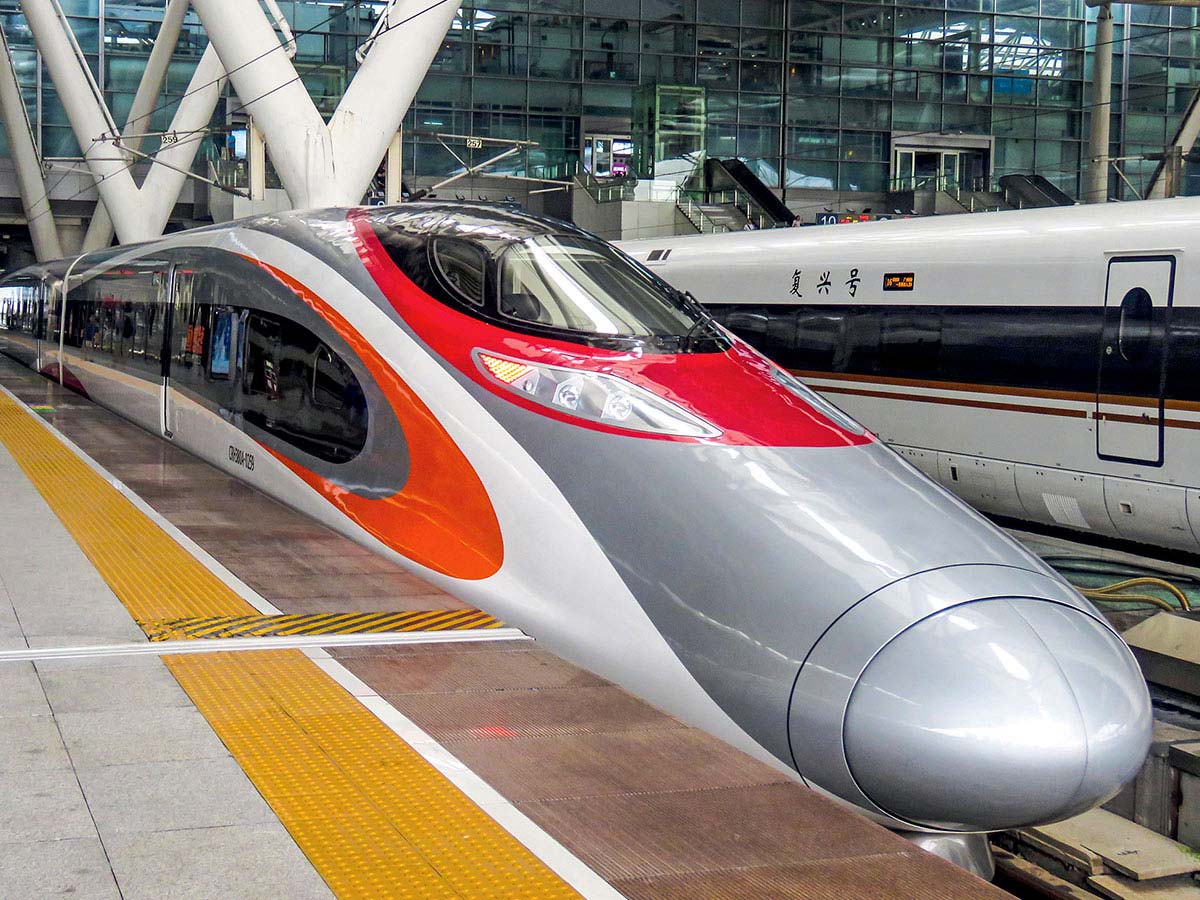TOKYO > HAKODATE

2016 | Japan
Journey

More Info
- Length in km: 823.7 km
- Name of the train: Hokkaido Shinkansen
The northern region of Japan’s main island remains a natural paradise, a landscape of great lakes, steep rocky cliffs, and volcanic mountains covered with snow in wintertime. Tohoku, far from the bright lights of the capital city, has become a desirable destination for eco-tourism. It was, therefore, quite a challenge to build a high-speed line to pass through this extremely uneven landscape, then to cross the Tsugaru Strait to reach the island of Hokkaido. Running on this Tokyo-Hakodate line are the Shinkansen trains, setting the standard for design, comfort, and performance. Thanks to the advent of high-speed rail, the southern and the northern regions have grown much closer to each other.
Leaving Tokyo
Tokyo Station is very much a city within a city, a space for culture, shopping, leisure, and a business centre. The station is centrally located in the Marunouchi district. A few steps west lie the Imperial Palace and its famous surrounding gardens, covered with cherry blossoms in the spring. To the south is the chic quarter of Ginza. The red brick rail station stands in remarkable contrast to the city’s skyscrapers. Erected in 1914, the station was entirely renovated in 2012, to reinforce resistance to seismic activity and to develop the shopping concourse. Activity is mostly concentrated below street level, where travellers and window-shoppers stroll through a vast labyrinth of underground passages, one of which is over four kilometres long.
Here is a gallery dedicated to pop culture enthusiasts, there a food court full of restaurants and fast food shops. On ground level, there is an art gallery and many shops, while the south sector boasts a luxury hotel, the Tokyo Station Hotel. There are smoking cabins on the platforms as well as lunch boxes for sale to passengers. Though this gigantic station receives hundreds of thousands of travellers every day, it is only the third-largest station in the city in terms of passengers, after Tokyo Shinjuku and Tokyo Ikebukuro.
History
After the success of the first Tokyo-Osaka line, Japanese authorities were encouraged to pursue major infrastructure works in order to extend the high-speed network to reach all regions. Projects were developed from the south to the north, in successive section increments, despite the natural obstacles encountered along the line. In 1982, the Tohoku Shinkansen was placed into service between Omiya (north of Tokyo) and Morioka, then extended in 1991 toward Tokyo. In 2010, the line reached Aomori, in the north of the archipelago. Finally, in 2016, the Hokkaido Shinkansen line connected to the island of its name, thanks to the Seikan Tunnel. Constructed in 1988, this tunnel was for a long time the longest in the world, surpassed only by the Gotthard Tunnel in Switzerland. The Seikan is equipped with a double gauge track to receive high-speed trains. From then on, passengers have been able to travel from Tokyo to Hakodate in less than four hours. Hokkaido Island residents look forward to when the Shinkansen will reach the charming city of Sapporo, the country’s premier winter sports destination. Patience is a virtue, to be rewarded in 2030.
Tokyo-Hakodate, the journey
Once past the sprawling city of Tokyo, the train runs through green countryside, cultivated in part with terraced paddies where a high-quality rice is grown. The Shinkansen passes close to Nikko and its fabulous array of richly-coloured temples, inspired by Chinese architecture. The line then enters the wild and harsh region of Tohoku, isolated behind tall mountain ranges and sweeping forests. Thanks to efforts undertaken by authorities, this region - devastated both by the tsunami and the 2011 nuclear accident in Fukushima - has now been almost entirely rebuilt. Off the coast of Sendai, Matsushima Bay offers one of the beautiful panoramic views of the archipelago and its two hundred pine-covered islands. A stop at Morioka, in the shadow of 2000-metre-elevation Mount Iwate.
The train continues on, not far from the high mountains of Hakkoda, which boast the finest powder skiing in Japan. The north is the region of Kokeshi, the round-headed traditional dolls hand-carved from cherry or maple wood. The port town of Aomori faces the Mutsu Bay and the strait that separates the northernmost point of Honshu from Hokkaido. The train then travels underground only to reappear at Hakodate, the current terminal station for the Shinkansen.
The Seikan Tunnel
Approximately 675 kilometres long, the Tohoku Shinkansen is the most extensive line in the country. One hundred and fifty tunnels mark the course of the rail line. In 2011, major renovation works were required in the wake of an earthquake that rocked the Tohoku region, but as testimony to legendary Japanese efficiency, the line was restored in only 49 days! The most important engineering work, extending the Tohoku Shinkansen to Hokkaido Island, is the Seikan Tunnel. The tunnel is 53.8 kilometres long, 23 kilometres of which are under the waters of the Tsugaru Strait. It is in fact the deepest rail tunnel in the world: the sole circulation gallery was excavated at a depth of 240 metres below sea level and 100 metres below the ocean floor. The construction of this tunnel was precipitated by a pivotal event. In 1954, the Strait was the site of a terrible maritime catastrophe: the sinking of a ferry during a typhoon, which cost the lives of a thousand passengers. In 1971, drilling began from both sides, and the junction of the two segments took place in 1983. The tunnel was inaugurated five years later. A total of seventeen years, then, were required to complete the works, as most of the gallery was dug from volcanic rock that required the use of explosives. Double gauge track was laid to make way for the Shinkansen. Two passenger stations were built inside the tunnel, underground. Travellers can discover the history of the tunnel in an exhibition on display.
Two different networks
Unlike most of its European counterparts, the Japanese high-speed network is not connected the classic rail network, due in part to the different rail gauges.
→ The Shinkansen H5 series emerging from Seikan Tunnel.
In anticipation of earthquakes
Japan, a country that is shaken by an average of three hundred earthquakes per year, is at the forefront of para-seismic technology. Japanese railways are equipped with high-performance preventive techniques. Seismic stations take measurements of underground vibrations at regular intervals, and the network is endowed with seismographs that are capable of detecting earthquakes and set off emergency brakes on train sets travelling at 320 km/hr. In function of the gravity of this problem, an alert system will be activated on board, slowing or completely stopping the train at the first sign of seismic activity. It is because of this safety feature that no train was derailed during the very violent earthquake of 2011. In the case of heavy rains, snowstorms, or typhoons, rail speeds are also automatically reduced.
Station shopping and services
Japan was quick to introduce commercial activities in its many rail stations, and to revitalise their neighbouring districts. It is without doubt the first country to have understood that the rail station can drive urban renewal and revitalisation at both district and city levels, and that the commercial aspect of this renewal is essential to economic viability. Office towers, hotels, and parking lots have sprung up around the rail station, which are very well connected to urban transport networks such as the metro, buses and tramways. State of the art rail stations make best use of underground spaces to create cities within the city. Small businesses benefit in equal measure to multi-level shopping centres.
Smartcard
Japanese fans of technology clamoured for the Suica and Kitaca pre-paid smart cards, which can be used on all transportation networks. These cards make it possible to travel anywhere, to make purchases at vending machines and in shops, whether buying a mountain rail pass or an urban transit.
→ The futuristic lines of the Shinkansen E5 series.
The Shinkansen
The Shinkansen E5 series that travels the Tokyo-Hakodate line is the pride of JR-East, as is known the East Japan Railway Company. Its futuristic lines, very long nose, and colour scheme - green and white with a magenta line – reflect the next generation of aerodynamics and design. Luxurious, fast, and very comfortable, the train reaches speeds of 320 km/hr on the lion’s share of the circuit. In terms of development, a serious effort was made to reduce noise on the Shinkansen. Frequent city crossings and the presence of inhabitants living near the rail track forced contractors to study and improve rail technology. In the same vein, the “long nose” of the motor improves aerodynamics and reduces pressure when travelling through tunnels.
Another train, the Shinkansen E6 series, also runs on this line, as well as between Morioka and Akita. Much less futuristic, the train is known as the “mini Shinkansen” for its smaller format. Its red and white livery and general shape were inspired by Namahage demons as well as kantō festival lanterns. This Shinkansen is coupled with an E5 series train. The E5 interior is very elegant, and offers three categories of service: ordinary class, Green class (business class) and Gran Class(first class). This luxury car, introduced in the latest Shinkansen models, has class indeed. Each car has only 18 armchairs, in cream-coloured leather and details in dark wood. On-board services offer meals and drinks that reflect the specialities of regions serviced by the train. On this line, between Tokyo and Hakodate, the train names evoke destinations as well as speed. The E5 - the fastest of all at 320 km/hr –is named Hayabusa, which translates as “peregrine falcon”, and its logo is inspired by the bird of prey in flight. The Hayate (“breeze”), Yamabiko (“mountain echo”) and Nasuno (“highlands”) run frequently at speeds of 275 km/hr.
→ Hokkaido Island: view over the city of Hakodate from the mountain that shares its name.
Arriving at Hakodate
The arrival on Hokkaido Island is not what people expect when they think of Japan. This has always been a land of hunters and fishermen, and remains sparsely populated (5 million residents) outside of the capital of Sapporo and a few other cities. Mountain highlands, smoking volcanoes and forests as far as the eye can see, providing resources for local timber and paper industry as well as handicrafts. The sea provides the island’s primary resources: crab, sea urchins and squid are the mainstay of local cuisine. Hakodate is a charming town, with a lively port and the old docks converted into a tourist district. The Shin-Hakodate Station is currently the end of the Shinkansen line until it reaches Sapporo, and isa 20-minute train ride from downtown Hakodate. With its large windows, pillars inspired the poplar trees at a nearby Trappist monastery, and cedar interiors, the station reflects a simple elegance.
Punctuality, a way of life
For a network that is subject to intense exploitation, the extreme regularity of Japanese trains is unequalled: the annual average delay per train is … 6 seconds! This punctuality is the conjunction of a precise organisation, the discipline of both staff and passengers, and the professional pride of rail agents. The performance of cleaning teams upon each train arrival is astonishing. In Tokyo, when the train pulls into the station, passengers descend to the platform. In an instant, the teams board with their cleaning carts, one per car. With only a few minutes to turn chairs to face forward (the train will now change direction), clean, and disembark. During this brief lapse, travellers wait patiently on the platform, each respecting the other, on coloured lines traced on the ground to indicate various rail lines. This ballet takes no more than 12 minutes until the train is ready to leave the station once more.
a selection of HIGH-SPEED LINES by creation date
1964

TOKYO > OSAKA
1992

TURIN > NAPLES
1992

MADRID > SEVILLE
2002

COLOGNE > FRANKFURT
2008

BARCELONA > MADRID
2010

SEOUL > BUSAN
2011

BEIJING > SHANGHAI
2014

ANKARA > ISTANBUL
2014

LANZHOU > URUMQI
2016

SHANGHAI > KUNMING
2016

TOKYO > HAKODATE
2016


ZURICH > MILAN
2018

BEIJING > HONG KONG
2018

TANGIER > CASABLANCA

